Strawberry variety Queen Elizabeth
Many have heard about the wonderful variety of garden strawberries Queen Elizabeth. He quickly gained great popularity, and for good reason. Currently, it is difficult not to find this strawberry on the site of any gardener, because it perfectly combines the most important qualities - large size and great taste of berries, as well as their excellent appearance, high yield and early amicable ripening, good resistance to diseases and pests ...
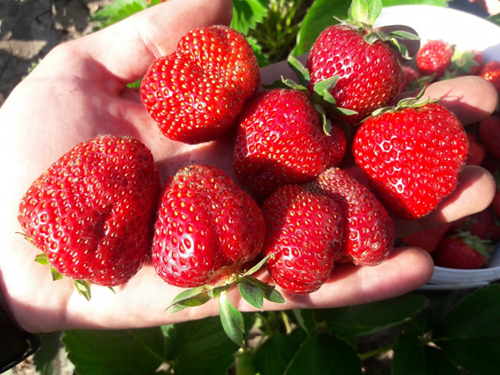
In general, there are two varieties - Queen Elizabeth and her "improved version" with the same name, but with an additional number 2. The first of them, presumably, was bred in England, it is a non-repair variety and bears fruit only under long daylight hours (more than 8 hours ). The second one was born thanks to the breeders of LLC NPF “Donskoy Nursery”, who singled out the best specimens on the plantations of the first Elizabeth, distinguished by higher yields and the largest sizes of berries. Serious breeding work was carried out on these record-holding plants, as a result of which a new variety of strawberries called Queen Elizabeth 2 appeared, surpassing its "parent" in all respects, and besides having remontant properties. But first things first. We will start with the "original" Elizabeth, because, despite the existence of an improved version of herself, she still remains very popular and certainly deserves attention.
Queen Elizabeth
Strawberry bushes are quite tall, powerful, very spreading. The leaves are large, concave, light green, shiny. The denticles of the edges of the leaf plate are sharp. The variety forms a mustache very much. The flowers are white, untwisted. Peduncles are strong, erect, located at the level of leaves, do not tend to fit on the ground under the weight of the crop.
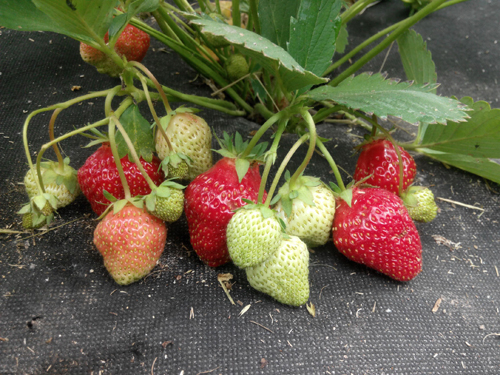
The berries are large, of the correct rounded-conical shape; at the first harvest, comb-shaped fruits may predominate. The skin is red, shiny. The pulp is quite dense, juicy, with a well-defined aroma. The taste of the first Queen Elizabeth is sweet and sour, harmonious, but in terms of taste she is noticeably inferior to her improved version. Berries are versatile in use, good in any form. They also perfectly tolerate transportation and short-term storage (about 3 days). The strawberry fruit is beautiful in appearance and remains dry and flavorful after harvest, making it suitable for commercial cultivation. Still, it should be said that Queen Elizabeth 2 almost completely ousted the first from large plantations of agricultural firms, and at present the "original" variety lives only on the private plots of gardeners and in small farms.
Fruiting begins with a long daylight hours, from about the beginning of June. The strawberry harvests quickly, ripens very amicably, which facilitates collection. However, there is one caveat - fruiting takes place in a short time, especially in regions with short summers. Thus, the yield of the first Elizabeth is significantly inferior to the second, to a greater extent precisely because of the duration of fruiting. When it comes to the size and weight of the berry, the differences between the two relatives are not that great. In the "original" variety, the average weight of berries in the season can fluctuate in the range of 20-30 grams, depending on agricultural technology and weather conditions. At the first harvest, giant fruits up to 100 grams can form, but a more achievable result is 40 grams. By the way, strawberry fruiting is stable, berries are only slightly smaller by the end of the season.
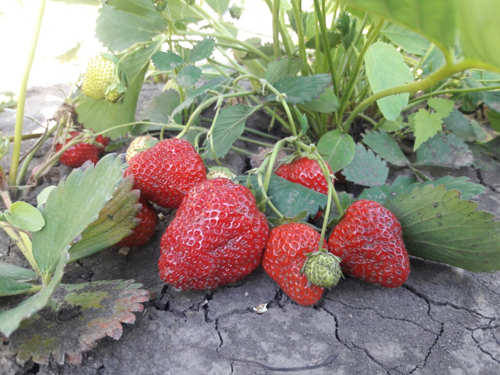
The average yield per plant is 1 kg, but it can reach up to 1.5 kg with proper agricultural technology.It is worth noting that such indicators can be safely considered high, the variety can confidently compete with other popular varieties on the market. But, of course, she loses noticeably to her follower. In terms of some other characteristics, the "relatives" do not differ much, so let's move on to describing the second variety, which easily displaced the previous queen from the strawberry throne.
Queen Elizabeth 2
Before proceeding with the main part, a small remark should be made. The appearance on the market of a new variety caused a great sensation, and many unscrupulous sellers of seedlings took advantage of this. So, in the assortment of agricultural firms appeared various "Super-Elizabeth", "Real Queen Elizabeth" and other "false queen", which in fact are either the original Queen Elizabeth, or her descendant, who stirred up the strawberry market. However, the same descendant generally has a more modest name - simply "Elizabeth 2". Under this name, the variety was presented by the originator, and specifically under this name it was registered in the State Register of Plants of the Russian Federation, in which it was entered in 2004 with admission to cultivation in all regions of the country.

The plant is erect, semi-spreading, more compact than its predecessor. The mustache is medium, green, formed in small quantities. Leaves are medium in size, medium wrinkled and medium silvery, concave, with sharp teeth. The leaf plate is green in color with a glossy sheen. The flowers are medium-sized, untwisted, colored white. The plant forms bisexual flowers, however, according to gardeners, the presence of another pollinator variety nearby has a positive effect on productivity. The strawberry inflorescence is multi-flowered, spreading. Peduncles are located below the level of the leaves, often laid on the ground under the weight of the fruit.
The berries are very large, with a wide conical regular shape, with a neck, sometimes ribbed, and comb-shaped can be observed. In general, the shape of the fruit is not stable, do not expect the berries to be "one to one". The skin is bright red, shiny. Achenes are numerous, light yellow. The flesh is red, firm, but without crunch, very juicy and aromatic. A feature, and at the same time a dignity of Queen Elizabeth 2, is the absence of voids inside the berry, which is often the case with some other large-fruited varieties, for example Gigantella Maxim.
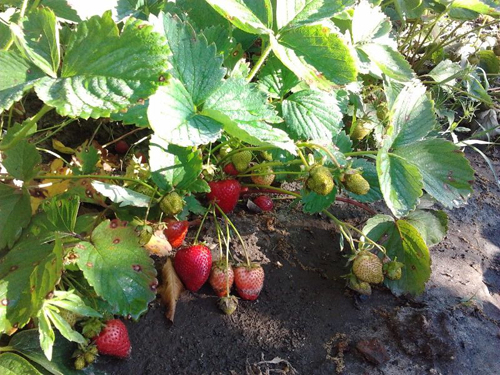
The taste of the variety is rich, very sweet, but at the same time with a pleasant light sourness, subtly emphasizing the sweetness. The aroma of the berries is pronounced, truly strawberry. Tasters rated the taste of strawberries at 4.7 points, and gardeners at all 5! The berries are great fresh and are great for all types of processing. They also tolerate transportation and short-term storage very well, after collection they remain neat and dry and have a very pleasant presentation. Only now, the heterogeneity of the shapes of the fruits may often not please the buyer on the market, but these are trifles.
The average weight of berries in the season is about 40-50 grams, some specimens exceed 120 grams, and there can be many such champions. The fruits grow quite impressive in size, but it cannot be said that they are the size of an apple. The berries have a large mass due to the absence of voids inside, and despite their smaller size than, for example, Gigantella Maxim, they are clearly ahead of other varieties in weight.
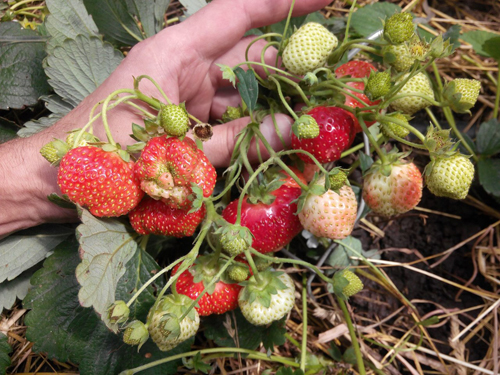
The yield of Queen Elizabeth 2 is very high - up to 10-12 kg per square meter. According to the results of state tests, the average strawberry yield was recorded at the level of 350 c / ha. And this is really a very big indicator! So, for the same Gigantella, with such a loud name, the yield is about 140 c / ha. Of course, the comparison is not entirely correct, since Gigantella is a non-repairable variety.If we draw an analogy with remontants, for example, with the popular Albion, then here too Elizabeth 2 wins noticeably - Albion has a declared yield of up to 2.4 kg per plant, and our heroine - up to 3.2 kg! Of course, it should be understood that such high results require very competent agricultural techniques and abundant "feeding".
Queen Elizabeth 2 is distinguished by an earlier ripening period than its predecessor - the first harvest can be harvested in mid-May, in the northern regions a little later. Fruiting lasts until about the end of September in the open field, and indoors the plants can bear fruit all year round. The variety is remontant, therefore, throughout the season, the yields are consistently large, the size of the berries does not decrease. When grown outdoors, three peak strawberry fruiting waves are distinguished - at the end of May, mid-July and in September. Ripening occurs amicably, which is very convenient when cultivating for commercial purposes - the collection takes place in a short time, which, for example, Kimberly cannot boast of.
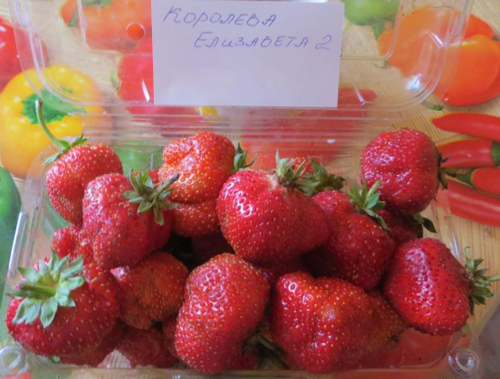
The variety is resistant to a wide variety of diseases and pests; during the years of passing state tests, it was very rarely affected by all kinds of ailments. It also has good winter hardiness, it perfectly tolerates severe winters even in the northern regions. The only thing to pay attention to is the protection of plants from spring frosts. Flowering occurs quite early, and if you do not take care of planting during this period, the flowers can be seriously damaged, and therefore the first harvest will not please you. According to gardeners, this strawberry is very "tenacious" and calmly endures a variety of unfavorable periods. Incidentally, the original Queen Elizabeth has exactly the same characteristics.
Features of agricultural technology
It's time to talk about growing. Let's start with the first Elizabeth. In agricultural technology, it is quite simple and does not require much attention. It is only important to carry out the most standard measures, monitor sufficient soil moisture, and timely fertilize. She does not require a lot of feeding, two or three per season will be enough. Particular attention should be paid to the removal of the whiskers, as strawberries form them in large quantities. They pull on a lot of nutrients, therefore, if their number is not normalized, the berries will become smaller. Do not forget to rejuvenate the plantation in time. For this variety, such an event is required to be carried out approximately once every 2-3 years, depending on the intensity of use.
Now let's move on to the intricacies of growing Queen Elizabeth 2. It should be said right away that agricultural technology greatly affects the yield of this strawberry, and it depends only on you how much its huge potential will unfold.
- Before planting, the site must be properly fertilized. Don't skimp on organic fertilizers to get your plants off to a good start. A minimum of 7-8 kg of humus is applied per 1 square meter, then the site is well dug up, the soil is allowed to settle, and only then the plants are planted. It is also extremely important to provide seedlings with mineral nutrition from the first days of their life in a new place. When planting, it is desirable to add phosphorus complexes to the soil. In a word, the yield and health of our remontant to a large extent depends on the fertility of the soil, and it is clearly not worth neglecting the application of fertilizers.
- As for the soil itself, the variety is moderately picky about its chemical composition, however, liming of soils with high acidity is highly desirable.
- The recommended planting density is 5-6 plants per square meter. Excessive thickening will result in lower yields and reduced berry size.
- Planting of plants is carried out according to the scheme: about 30 cm between plants and 60-70 cm between rows.
- The most important point is to provide Queen Elizabeth 2 with enough fertilizer. Plants require them throughout the season, and foliar feeding is often necessary, which can provide strawberries with a "quick" diet. Do not skimp on fertilizers, since the amount of the crop and its taste to a greater extent depend on abundant high-quality nutrition.
- The variety is remontant, so the plantation needs to be rejuvenated more often. It is impractical to use plants for more than two years, with intensive cultivation, the period is reduced to one year. Fortunately, strawberries produce enough whiskers and root well, so there will be no problem with reproduction. By the way, the newly formed whiskers are able to bear fruit on a par with the mother plants in the first year!
Much has already been said, so let's briefly summarize all of the above and mention some of the shortcomings of both varieties. Both Queen Elizabeths are beautiful and equally popular. But each has its own characteristics. As for the first, it has excellent taste and rather high yield rates, but its fruiting period is short and depends on the length of daylight hours. And of course, she is inferior to Elizabeth 2, who has the same merits, but multiplied by the same two. It is tastier, more productive, and can bear fruit all year round, but in return for such characteristics it requires much more care. Not every gardener is ready to pay so much attention to his strawberries, so the potential of the variety often simply remains undiscovered. But if you take good care of the plants, Queen Elizabeth II, and her predecessor, will reward you with a truly royal harvest!





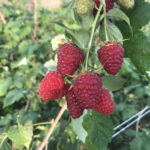



I grow Queen Elizabeth 2. The berries of this variety are large, dense, sweet. This is a remontant strawberry and we expect a bountiful harvest from it all summer. But this way of growing is very depleting of the plant and the fall harvest is very small. In addition, in the Urals in the Urals, the cold comes early in the fall, and the berries do not have time to ripen. Therefore, I prefer to get the main harvest at the end of July - August, when the usual varieties have already departed, sacrificing the June harvest. To do this, I cut off the first flowers on the plants, leaving only those that bloom later, when all the rest of the strawberries have already faded. In mid-August, when the temperature drops, I install arcs and cover the bed with a film or covering material. In rainy weather, film is even preferable. Queen Elizabeth 2 blooms and bears fruit on young mustaches, so I leave more distance between the rows, keep them loose and direct the antennae into them. It is the peculiarity of remontant strawberries to bear fruit both on the bushes and on the mustache that makes it difficult to reproduce. The mustache directs all forces to flowering and takes root poorly, and freezes in winter. Therefore, I do not allow the mother bush and antennae to bloom.
A wonderful variety. Fruiting several times per season.
We have been growing it for four years. I love.
I have many remontant strawberries, but this one is my favorite. It has been growing for many years and has never failed. The berries begin to ripen in early June, the first large, then, of course, smaller. The color is bright pink, the taste is sweet and sour, pleasant.All berries are neat, the pulp is moderately dense, juicy. I have never weighed it, but the harvest from each bush is decent. After the first fruiting, it rests a little and blooms again at the end of July. The autumn harvest is in no way inferior to the spring one, it is even tastier. Fruiting until the very frost, very often berries are left on the bushes, beaten by frost. I have 1 or 2 Elizabeth, I don't know for sure, but the variety is just amazing.